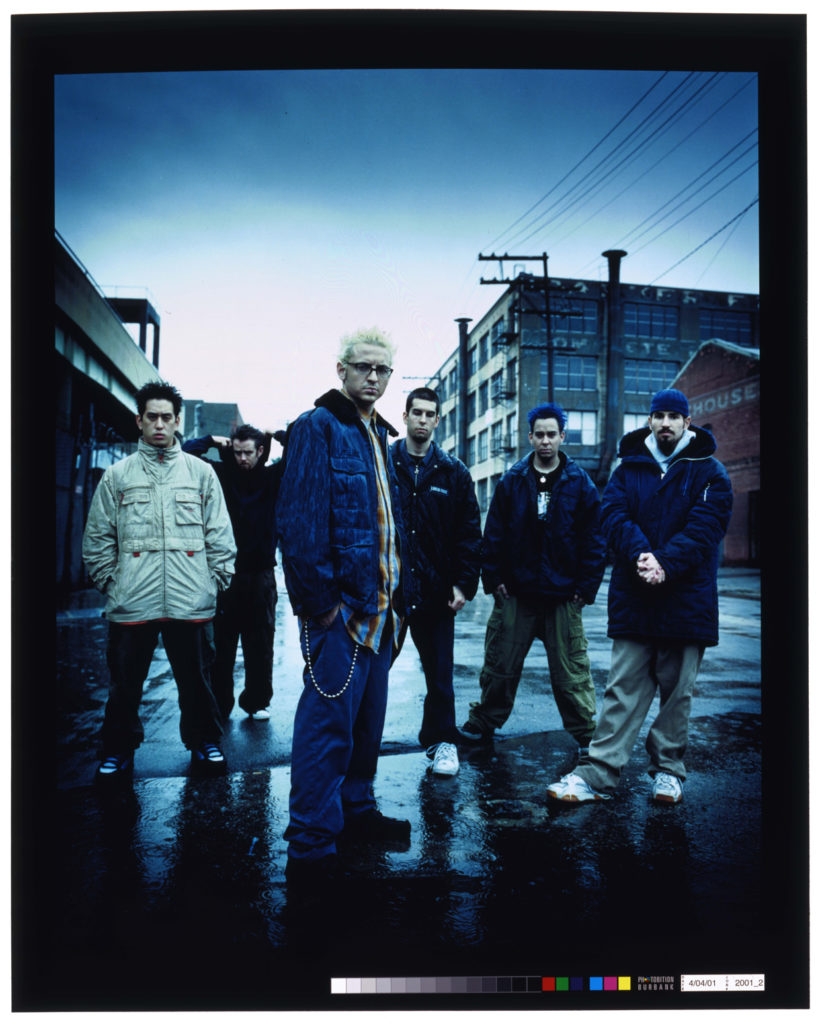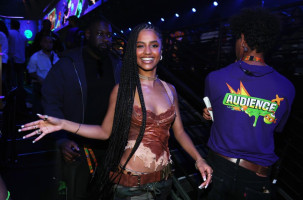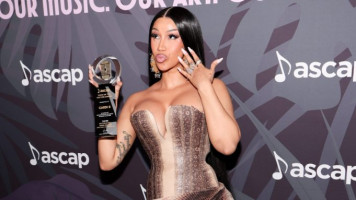“It was a bizarre, but very special, moment in time.” That’s how Linkin Park’s Mike Shinoda describes the release of the band’s seminal debut, Hybrid Theory, one of the best-selling rock albums of all time.
Upon the album’s Oct. 24, 2000 release, the members of Linkin Park were in their early twenties -- “just children, screwing around,” as Shinoda affectionately describes the group’s early days in the Los Angeles suburbs. With Shinoda and Chester Bennington sharing the frontman role, Linkin Park offered a bold progression on the strand of rap-rock that had bubbled up the charts in the late ‘90s. They often delineated the rapping and singing duties between vocalists and carefully balancing hard rock riffs from guitarist Brad Delson with hip-hop-style beats from drummer Rob Bourdon and turntablist/DJ/programmer Joe Hahn.
The band’s mixture of rap and rock was approached with some skepticism from their label, Warner Bros. Records, and their producer, Don Gilmore. Yet as soon as “One Step Closer,” Hybrid Theory's blistering lead single, became a top 10 hit at U.S. alt-rock radio, those doubts were quickly alleviated.
“When I grew up, you were either a rock kid or a rap kid, but you didn’t listen to blended music, really,” Shinoda recalls. “I was so excited when Rage Against The Machine came out, and Red Hot Chili Peppers, or when I found Led Zeppelin by listening to Beastie Boys. There were things that were out there that took from varying styles of music and put them together, but they were not the norm at all. And to have played a role in mashing styles together, that is, for us, part of our legacy that we’re proud of.”
Indeed, Hybrid Theory remains a touchstone of the time period: the album has sold a whopping 10.8 million copies to date, according to Nielsen Music/MRC Data, and produced singles that have remained alternative radio staples for decades. “In The End,” the brilliantly rendered signature anthem that mixes rap verses and a melodic hard rock chorus, peaked at No. 2 on the Billboard Hot 100 chart, while “Crawling” earned Linkin Park its first Grammy award. The album would kick-start a career that produced seven total albums, 28.8 million total copies sold, and countless arena performances, until the tragic passing of Bennington in 2017.
Now, the band is looking back on its landmark debut with Hybrid Theory: 20th Anniversary Edition, a new collection featuring previously unreleased demos, B-sides, rarities, DVDs and the long-sought-after fan favorite track from the time period, “She Couldn’t,” among many other things. The multiple configurations of the boxed set -- including a Super Deluxe Edition with 5 CDs, 3 LPs and 3 DVDs -- will be released on Friday (Oct. 9); in addition, Sirius XM has launched a limited-run music channel “Linkin Park Radio” on Oct. 5 to commemorate the anniversary.
“It’s a nice time to pause and think and focus on what it took to make that record, the impact it had, and the opportunity it allowed us to continue with our careers,” Hahn tells Billboard. “For me, it’s a testament to the camaraderie between all the guys in the band, to our friendship, to our work ethic, to the values in how we approached not just making music, but the business of making music, and the way we interact with our fans.”
In separate interviews, Shinoda and Hahn shared their memories of all 12 songs on the standard edition of Hybrid Theory, from the biggest hits that the album spawned to the deep cuts that hold a special place in their hearts. Check out their track-by-track remembrance of Linkin Park’s Hybrid Theory below.
1. “Papercut”
MIKE SHINODA: To me, the two songs that were the most important were “Papercut” and “In The End.” “Papercut” was all of the identity of the band packed into one song. Even the fact that it started with that beat, and it went straight into a double-time bouncy rap with heavy guitars, the fact that Chester was rapping with me on the chorus -- you can’t even hear him because of the mix, it sounds like it’s just him but it’s actually both of us.
When you got to the bridge, that soaring, huge vocal! And we didn’t come back to a chorus at the end of it, it was a unique song structure. I feel like it checked a lot of the boxes in terms of what the band was really about. And we knew, from the moment we had the song, we knew it needed to open the album.
JOE HAHN: “Papercut” at the time was one of my favorites. We were really trying to mash up styles, and I think we did that pretty successfully. The idea of bringing the breakbeat element that hip-hop has, I think we got pretty cool vibe when we intertwined the guitar riffs with the drum break on that song. The album’s called Hybrid Theory because it represents that ideal.
SHINODA: There was a weird thing with the singles on this album. Technically, there were three singles: it was “One Step Closer,” “Crawling” and “In The End.” And then there was a European single, which was “Papercut.” The reason was that “Crawling” was still going strong at radio in the States, but the European radio market moves faster, so they’d already burned through two singles and they needed a third one. [The label] basically wanted to time it out so that the European market had a third single, and then we could go worldwide with “In The End.” They were like, “We want everything to culminate with ‘In The End,’” and the momentum ended up working out that way.
2. “One Step Closer”
SHINODA: In choosing Don Gilmore as a producer, we were really hesitant. Don had more of these radio-alternative songs, and we knew that he would get that part of our sound right, but he knew nothing about hip-hop. Not a thing! And he said that to us when he met with us. He was like, ‘Here’s the deal, the part of your sound that I can’t contribute to is the hip-hop part. I know that’s a big part of your thing. But I like how you do it, so I will try to just get out of the way in terms of the beats and raps and stuff, I will leave that to you.’ And we were like, ‘Okay!’ And that worked out great, because we didn’t know how to mic up and engineer a rock band in the studio. We didn’t know how to arrange, how to multi-track guitar and vocals, in a way that sounded like what we heard on the radio that we loved. So that was all us learning from Don.
As we got into it, we did have these real tense points of conflict, because since he was hands-off on some of the creative in terms of letting us dictate how the hybrid was supposed to work, when somebody from the label came in and said, “I don’t like what they’re doing with mashing up these things,” or if they came in and said “I’m not sure about the rapping,” then all of a sudden Don couldn’t definitively defend it. He was like, “Uh, okay, well, that’s what the band thinks sounds good!” The power struggle became part of what making that album was. Some of the intensity and frustration you hear on the album is specifically album-related.
“One Step Closer” was me and Chester literally writing about Don. We were so mad at him. The ‘shut up’ riff was literally Chester screaming at Don. We were losing our minds. At that point in the process, it was just like, why don’t you trust us? This is our album. Our A&R guy doesn’t have to have his f--king name on the front of the CD, and play this music onstage everyday. We knew, if we put anything on this record that we don’t like or that we’re not feeling, we’re gonna have to live with it. Like, this is our career!
HAHN: I feel like, at that time, that was our loudest song, which turned into the first single. In making that record, we weren’t completely understood by the record label, mainly because there was a categorization of what bucket you fit in. Being a rock band but trying to have a firm foundation with our hip-hop and electronic influence that we bring to the music. The formats were alternative rock and active rock at the time. I remember the label at one point asked us to have less rapping, and less scratching. If you actually listen to the radio edits of that song from when it first came out, they took out the scratching on the bridge of the song, which I found kind of annoying and unnecessary.
SHINODA: The “shut up” part in the bridge, I know one of my reference points was “F--k you, I won’t do what you tell me” [from Rage Against The Machine’s "Killing in the Name"], and we wanted a part like that in one of our songs. And we were in the studio writing and re-writing “One Step Closer,” and eventually we got so mad that Chester was just writing words down about how mad he was at Don for making us rewrite s--t. And eventually he wrote down “Shut up” and I was like, “What if the bridge is just ‘Shut up’? What if it’s simpler than anything we’ve said so far?” Because we were just writing out lyrics. And he was like, “I think that’s gonna sound awesome!”
We went in and told Don, “Put up ‘One Step Closer,’ we wanna record the bridge.” He was like “Well, tell me what it is.” And we go, “No no no, it’s better if we just record it. Listen to it in its full concept.” [laughs] And Don was like, jumping up and down. I think he figured out eventually that the whole song was about him. At least in part -- it wasn’t just about him, but part of it was inspired by how frustrated we were with him.
3. “With You”
HAHN: We worked with the Dust Brothers on that -- previous to that, they did [Beastie Boys’] Paul’s Boutique, so they were definitely a part of our history of music. They basically gave us a bunch of stems from an unused remix that they had, so we constructed that into the song. Some of the sounds at the beginning, like that ‘Dun-dun. DUN,’ some of the loops and drum breaks in there are from them.
I remember being really excited at that time, working with them, because it just represented a new way of making music, re-assembling parts that sounded cool into something totally different. It was fun to do that in a collaborative fashion.
SHINODA: I always liked “With You”! It was more ‘of the time,’ it was very nu-metal, so for better or worse, that’s what that was really about. I really like Joe’s parts on it. I like the production, the beats and stuff that I did -- we had a lot of back-and-forth about the production on it.
4. “Points of Authority”
SHINODA: There are a couple references on “Points of Authority” that are interesting. The vocal scat thing that I do on the intro, that’s really inspired by the Roots and Black Thought. I heard him doing that on Illadelph Halflife, and I just thought there was something so cool about that. And I thought it would mix well with the scratching, so we kind of did this back-and-forth with those things. The guitar line of the song was originally completely different -- I think we actually included the original riff, the original version of the song, on our boxed set for Hybrid Theory. But at some point we realized that the original guitar riff was really basic, so I went into Pro Tools and chopped it up, and moved the pieces around just to experiment with how it could sound, and I treated it like a sample off a record.
The song didn’t have the current chorus for a long time -- we basically wrote that chorus while we were in the studio with Don, because we decided it needed something melodic but we didn’t want it to be too soft, so we opted for this really simple, two-chord yelling-shouting melodic part.
HAHN: I direct the majority of the music videos, so I had a lot of fun making that one [for a version of the song on the band's 2002 remix album Reanimation]. We story-boarded that whole video, and worked with an animation team in L.A., and went, “Let’s just create this world, and it’s gonna be this race against this race, and they’re battling it out.” I remember I was referencing Saving Private Ryan, and looking at a lot of anime, and the dynamics of things blowing up. It was so fun, because I had this crazy idea, and everyone was like, “Okay! Go do it!” And they let me do it!
5. “Crawling”
SHINODA: The “One Step Closer” video, we had a very modest budget for that, and we had never made a video before. So when it was time to do a second video, we had a little more money, and I think the label was really instrumental at that point in helping us find a really good team to make a good video. And Joe started to get more confident about asserting himself in the process -- during “Crawling,” he really got in there, and probably learned a lot, and asked a ton of questions. But it came out great, the video was really an important part in introducing people to the band.
HAHN: “One Step Closer” is a pretty aggressive song, and it’s not very sweet-sounding by any means. When “Crawling” came out [as the second single], it represented a different side of what we do, intertwining something very intimate with an outpouring of emotion in the chorus and bridge, and even with some screaming. We always tried to play with what works, with the music and the dynamic of the vocal that Chester and Mike would bring to the table. Funny thing too, because the first song was such a big deal at the time -- and then we come out with “Crawling,” which is more of a softer side of what we do. I think if you got the album, you really understood it, but people that didn’t were like, “How does this song have anything to do with that other song?”
SHINODA: We won a Grammy for “Crawling,” for best hard rock performance, and at the time I didn’t know the difference between “hard rock song” and “hard rock performance,” since they had Grammys for both. And eventually I was like, “Oh, this is a Grammy for Chester’s vocal.” Like, it was a great recording, but if we really want to be super honest, the reason we got that Grammy was because of Chester’s performance on that song was bananas. It was so insane! I don’t think I’ve ever heard him sing like that. And it’s just that extra fierceness in his vocal that we captured that day. Just once in a while, he would walk in with that going on in his voice, and we knew we had to record as many things as possible whenever that happened. [laughs] It was like, can we please do five songs that day?
6. “Runaway”
SHINODA: “Runaway” was originally a song called “Stick and Move,” and the lyrics were really trite, but it was super bouncy and fun to play. At all of our early shows, that was basically our big song -- people who would come to our shows for the first time, we would talk to them afterwards and mention that song. So we always thought, this is an important song to get right in the studio. And once we had some of the other songs starting to take shape, we were like, “Oh no, one of our best songs is now one of our worst songs.” We thought we had this gem, and now it’s turning to be kind of a mess.
We completely disassembled the song and re-wrote it. We kept the chords and some of the drum grooves, but added a bunch of new stuff to it, and rewrote all the lyrics, and it became “Runaway.”
HAHN: There was definitely this thing we were doing repeatedly, just trying to master the song structures, going from lulls to reaching climaxes back to the lull. This song represented that formula that we mastered before we started to explore different ways of writing songs. If you break it down, it’s much simpler than some of the later music.
SHINODA: “Runaway” is funny, because some people think that it was a single from the album, but that’s just because a bunch of radio stations started playing it without us even promoting it as a song or doing a video. It was just a time when everyone was so enamored with the album and the band that they would just play album cuts. It was unbelievable.
7. “By Myself”
HAHN: That was one of the songs that we carried over [from early demos], too. I remember it being like this quiet-to-loud, really cool vibe, going from almost a whisper to grabbing your shirt. I think it had a lot of conviction, and when we played it live it definitely had that vibe where people were just amped up from listening to it.
SHINODA: “By Myself” was our attempt to do the softest verses and every other parts of the song be the nastiest, loudest sounds we can. And so it was drawing more from like, Nine Inch Nails and Ministry, than some of the more nu-metal stuff.
I remember doing the demos for that song in my apartment in Glendale, in the L.A. area, and my neighbor just f--king hated me. The walls were paper-thin, Chester’s screaming the chorus, and they must have thought we were murdering somebody in the room. We were both just shouting, and I’m going, “No, LOUDER!” [laughs] And my neighbors would bang on the wall at 10 PM every night to tell us that it was time to go to bed, basically. And thus, we would record all the way up ’til 10, and then you’d hear a thumping on the wall. We’ve got our headphones on, we’re doing our thing, and they’re literally punching the wall, trying to get our attention and tell us to shut the f--k up.
HAHN: The album is full of these moments like the one where Mike is saying “By myself,” and then Chester goes, “MYSELLLLLF!” That’s what was kind of magical about Mike and Chester as frontmen, partners and co-vocalists -- to have that sort of Jekyll-and-Hyde type moment. Two vocalists that could pull that off together really made us stand out from everyone else.
8. “In The End”
SHINODA: We had a bunch of tracks that we really liked, but we knew we needed something else that was a next-level kind of song. And I was having this moment of, I knew it was on me, I had to find it. I locked myself in our rehearsal studio on Hollywood and Vine -- back when Hollywood and Vine was like, drug addicts and prostitutes everywhere, so you wouldn’t just want to go in and out of there. Once it got to be about 7 o’clock, I went in there and locked the door and stayed overnight. There’s no windows or anything, I didn’t know what time of day it was. I wrote all night, and I ended up with “In The End” in the morning.
Our drummer Rob was the first one to show up that afternoon and I played it for him, and he absolutely lit up. He said something to the effect of, “I was dreaming, imagining that we needed a melodic song that took us to the next level, where the chorus was just the undeniable thing. This is the song. You made the song that I would have imagined.” So that was the first endorsement, and then after that, everybody we played it for had a similar excitement about it.
HAHN: We knew that we needed more melody. We knew we needed to round out what we were doing. People don’t want to be screamed at for a full record -- well, some people do. But everything from the melodies to the piano that loops... we write a lot of music, and for each album, there’s probably at least a hundred song ideas, sometimes double that. Sometimes there’s these magical moments where all of the elements come together perfectly at the same time. This is one of those ‘eureka’ moments.
SHINODA: The only part that we had a lot of drama around was my rap verses -- my original verses were okay, but our A&R guy at the time was really an insecure guy all around, and he kept going around to everybody else asking what they thought about the rap verses on that song. He’d play them and go, “These aren’t right, don’t you think?” And it was like, setting them up to pick something apart. He was the one who suggested that I not rap in the band, that I just be the keyboard player or whatever. Thankfully the guys, and Chester in particular, came to my rescue on that one.
9. “A Place For My Head”
SHINODA: “A Place For My Head” used to be called “Esaul,” and that was one of the earliest songs -- it might have been on the first demo that me and my friend Mark Wakefield made, when the band was just the two of us. And it went through different iterations to this version, but it was always a favorite. I think when it got recorded in the studio for Hybrid Theory, it was one of those scenarios where the song was already something we liked, but then when it was recorded the energy went up a lot, and it became a song that we always closed our shows with, either that or “One Step Closer.”
HAHN: For a while we were making these songs that had this outpouring of energy which would get people to mosh. I think that was our goal: to somehow lyrically and musically convey this feeling of frustration and tension, almost like you’re stuffing a bottle full of those emotions and then you’re shaking it up until it explodes. I think that song does that very well.
10. “Forgotten”
SHINODA: “Forgotten” was the other one that started as a demo with me and Mark. That one was called “Rhinestone” at the time. Both of these demos in their original versions are on Hybrid Theory 20, and we got Mark’s begrudging approval to put them on, with his voice and everything.
HAHN: That was cool, because back then, we were just putting parts together that fit. When I hear that song, I hear the ingredients, in a way that a chef might eat a dish and pick apart the different ingredients, in a very simple but elegant kind of way. It felt great to come out with a product at the end that represented exactly what we were trying to do at that moment.
SHINODA: As a side note, with the Hybrid Theory 20 release, we didn’t mix or re-mix any of the songs. It’s just a mastered version of the original cassette demo. People have asked a couple of times if we ever wanted to do a remaster, and the technology of mastering hasn’t changed a lot between Hybrid Theory and now. I remember telling everyone else who would listen [while making it], “I’ve got a subwoofer and an amp in the trunk of my car, I want to be able to put this record on right after Timbaland and Dr. Dre and have it thump just as much as those records. It needs to have the shape of a rap record.”
11. “Cure For The Itch”
HAHN: Mike had this really cool beat idea, those strings that were on the song. We really liked the feeling of it, but it wasn’t a song. I was like, “What if we put a beat to it, and an intro that I can scratch on?” We took the approach of making it a musical journey, and have it lean more on the DJ side of things. It gives a nice pause to the intensity of the album.
SHINODA: Joe and I loved DJ Shadow and Aphex Twin and so much of the electronic and trip-hop stuff that was coming out back then. One thing that happened when that community butted up against the DJ community is that there was a sense of humor that came through -- DJ crews, when they did their sets, they’d throw in little things that made you laughs. That’s why “Cure For The Itch” is a little bit lighter. It’s kind of flexing in terms of the beat production, but it has a little bit of a sense of humor. We wanted to give Joe a little bit of a spotlight track. We thought it’d be fun for him and that the fans would love it, so it’s very much a Joe experience.
12. “Pushing Me Away”
SHINODA: “Pushing Me Away” was like, basically we were really happy with how “Crawling” came out, so we were like, “Let’s do another melodic song like that!”
HAHN: That’s another one of those ballad-y songs, that’s like one of those conversations ... In recent years we brought it back into our live set, as an a cappella/acoustic version, because it was never a single but we really loved that song. I think that struck a chord with all the fans that loved Hybrid Theory.





